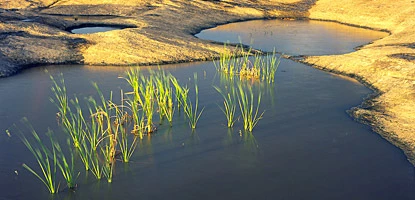
NPS Photo by Neal Herbert Throughout Natural Bridges, naturally occurring sandstone basins called “potholes” collect rain water and wind-blown sediment, forming tiny ecosystems where a fascinating collection of plants and animals have adapted to life in the desert. Potholes range from a few millimeters to a few meters in depth, and even the smallest potholes may harbor microscopic invertebrates. To survive in a pothole, organisms must endure extreme fluctuations in several environmental factors. Surface temperatures vary from 140 degrees Fahrenheit in summer to below freezing in winter. As water evaporates, organisms must disperse to larger pools or tolerate dehydration and the drastic physical and chemical changes that accompany it. The most extreme conditions exist when a pothole is dry. In addition to the wide temperature fluctuations, ultraviolet light from the sun can damage body tissues. Many aquatic organisms are adapted to acquiring oxygen through water and suffer when exposed to air. Pothole organisms have three main ways of dealing with drought. “Drought escapers” are winged insects, amphibians and invertebrates that breed in potholes but cannot tolerate dehydration (e.g. mosquitoes, adult tadpole and fairy shrimp, spadefoot toads). In some cases, adults live in permanent water sources or on land and travel to temporary pools to mate and lay eggs. If the pool dries out before the young mature, they die. In the case of tadpole, fairy and clam shrimp, adults must lay their drought-tolerant eggs before the pool dries up. “Drought resistors” (e.g. snails, mites) have a dormant stage resistant to drying out. These animals have a waterproof layer like a shell or exoskeleton that prevents body tissues from losing too much water while a pool is dry. By burrowing, these animals are able to seal themselves in the layers of fine mud that often coat the bottom of potholes and form an impermeable crust. “Drought tolerators” (e.g. rotifers, tadpole and fairy shrimp eggs) are able to tolerate a loss of up to 92 percent of their total body water. This remarkable process, known as "cryptobiosis," is made even more remarkable by the fact that many cryptobiotic species can be rehydrated and become fully functional in as little as half an hour. Cryptobiosis is accomplished by a command center that remains hydrated while substituting sugar molecules for water throughout the rest of the body. This transfer maintains the structure and elasticity of an organism's cells during long periods of drought, and enables the organism to withstand the climatic extremes of the desert. In fact, brine shrimp have been hatched from cryptobiotic cysts that endured a flight on the outside of a spacecraft. Many tolerators have only one stage in their life cycle (e.g. egg, larva) that can survive desiccation, and will die if a pool dries up during another phase. Pothole organisms not only have to endure dry spells, but also must evaluate conditions and decide when to break dormancy. Desert precipitation falls at irregular intervals, and once water enters a pothole there is no guarantee that there is enough for an organism to complete its life cycle. Most organisms living in potholes have very short life cycles, as brief as ten days, reducing the time water is required and allowing them to live in the shallow pools. Even vertebrates such as toads, which are found in other environments, display shorter development times when found in potholes. However, the presence of water may not be the only cue used by eggs and dormant life forms to activate. Oxygen content, temperature, and other physical and chemical factors of the water may be evaluated. Some organisms produce different types of eggs that hatch on different cues; others lay eggs in different areas so that they experience slightly different environmental conditions. The net result is that not all eggs hatch at once and the species has a better chance of survival. After a pothole fills with water, the small ecosystem experiences many other changes. Water temperatures can be very high, while oxygen levels can be very low. As the pool shrinks from evaporation, its salinity increases and the pH changes. Many organisms are capable of surviving wide fluctuations in these factors, but for some these changes are an indication that the time for dormancy is near. |
Last updated: April 18, 2025
